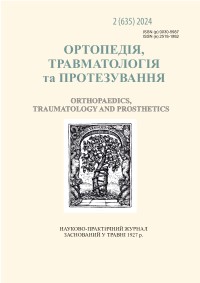SEPTIC COMPLICATIONS AFTER THE USE OF GLUCOCORTICOIDS (RESULTS OF CLINICAL LABORATORY AND PATHOMORPHOLOGICAL STUDIES)
DOI:
https://doi.org/10.15674/0030-59872024254-60Keywords:
Glucocorticosteroids, septic arthritis, injections glucocorticoids, diagnosis, osteoarthritisAbstract
In numerous articles, monographs, and textbooks, the aspects of local application of glucocorticoid injections at the current stage of development of rheumatology are considered from the point of view of expediency, effectiveness, and safety. Factors affecting the effectiveness of this method are analyzed. Periarticular and/or intra-articular injections of corticosteroids are included in various recommendations and protocols for the treatment of arthrosis and rheumatic joint lesions available today. Objective. Determination of pathomorphological, clinical and laboratory manifestations of the infectious process after local administration of glucocorticoid drugs. Methods. Clinical, anamnestic, laboratory, bacteriological and pathomorphological
data of 34 patients with infectious complications were analyzed. Results. The administration of long-acting drugs was most often used: DIPROSPAN — 13 (38.2 %) cases; KENALOG — 5 (14.7 %); DEPOS — 3 (8.8 %); FLOSTERON — 2 (5.9 %); a short-acting drug (methylprednisolone acetate (METYPRED), hydrocortisone acetate) was used in 11 (32.4 %) cases. At the time of hospitalization in the clinic, the infectious process was in 8 (23.5 %) patients in the acute stage, 10 (29.4 %) in the subacute stage, and in another 16 (47.1 %) in the chronic stage, 13 (38.2 %) of which are in the active fistula phase. Conclusions. Pathomorphological manifestations and signs of a purulent-necrotic and purulent-inflammatory infectious process (infectious complications) after local administration of glucocorticoid drugs accompany and are closely statistically significantly interrelated with typical clinical and laboratory manifestations (leukocytosis with a «shift of the leukocyte formula to the left», an increase in ESR and level CRP) and etiology («bacteriology») of the infectious process.
References
- Donell, S. (2020). Why do we not prescribe steroids in acute native septic arthritis? Knee Surgery, Sports Traumatology, Arthroscopy, 28(5), 1343-1345. doi:10.1007/s00167-020-05978-7
- Chan, B. Y., Crawford, A. M., Kobes, P. H., Allen, H., Leake, R. L., Hanrahan, C. J., & Mills, M. K. (2020). Septic arthritis: An evidence-based review of diagnosis and imageguided aspiration. American Journal of Roentgenology, 215(3), 568-581. doi:10.2214/ajr.20.22773
- Ross, K. M., Mehr, J. S., Carothers, B. L., Greeley, R. D., Benowitz, I., Henry, D., … Montana, B. E. (2019). Bacterial septic arthritis infections associated with intra-articular injection practices for osteoarthritis knee pain — New Jersey, 2017. Infection Control & Hospital Epidemiology, 40(9), 1013-1018. doi:10.1017/ice.2019.168
- Mohamed, M., Patel, S., Plavnik, K., Liu, E., Casey, K., & Hossain, M. A. (2019). Retrospective analysis of septic arthritis caused by intra-articular Viscosupplementation and steroid injections in a single outpatient center. Journal of Clinical Medicine Research, 11(7), 480-483. doi:10.14740/jocmr3838
- Beukelman, T., Guevara, J. P., Albert, D. A., Sherry, D. D., & Burnham, J. M. (2008). Usage of intra-articular corticosteroid injections for the treatment of juvenile idiopathic arthritis: a survey of pediatric rheumatologists in the United States and Canada. Clin Exp Rheumatol., 26(4), 700-703.
- McGarry, J. G., & Daruwalla, Z. J. (2011). The efficacy, accuracy and complications of corticosteroid injections of the knee joint. Knee Surgery, Sports Traumatology, Arthroscopy, 19(10), 1649-1654. doi:10.1007/s00167-010-1380-1
- Helito, C. P., Teixeira, P. R., De Oliveira, P. R., De Carvalho, V. C., Pécora, J. R., Camanho, G. L., … Lima, A. L. (2016). Septic arthritis of the knee: Clinical and laboratory comparison of groups with different etiologies. Clinics, 71(12), 715-719. doi:10.6061/clinics/2016(12)07
- Munoz-Gallego, I., Mancheño, M., Pérez-Montarelo, D., Viedma, E., Chaves, F., & Lora-Tamayo, J. (2020). Staphylococcus aureus native arthritis over 10 years. Medecine et Maladies Infectieuses, 50(3), 257-262. doi:10.1016/j.medmal.2020.01.012
- Helito, C. P., Zanon, B. B., De Souza Miyahara, H., Pecora, J. R., Lima, A. L., De Oliveira, P. R., … Camanho, G. L. (2015). Clinical and epidemiological differences between septic arthritis of the knee and hip caused by oxacillin-sensitive and -resistant S. aureus. Clinics, 70(1), 30-33. doi:10.6061/clinics/2015(01)06
- Chung, S. L., Papanikitas, J., Johnstone, D., & McKean, D. (2020). Septic arthritis caused byCandida albicans: Post intraarticular steroid injection in a native joint. BMJ Case Reports, 13(8), e233841. doi:10.1136/bcr-2019-233841
- Balato, G., Ascione, T., Iorio, P., De Franco, C., De Matteo, V., D’Addona, A., … Pellegrino, A. (2019). Knee septic arthritis caused by α-hemolytic streptococcus in a patient with a recent history of knee arthroscopy: A case report. BMC Infectious Diseases, 19(1). doi:10.1186/s12879-019-4556-4
- Erice, A., Neira, M. I., Vargas-Prada, S., Chiaraviglio, A., Gutiérrez-Guisado, J., & Rodríguez de Oya, R. (2018). Septic arthritis following arthroscopic reconstruction of cruciate ligaments of the knee: Retrospective case review. Enfermedades infecciosas y microbiologia clinica (English ed.), 36(6), 336-341. 10.1016/j.eimce.2018.04.005
- De Franco, C., Artiaco, S., De Matteo, V., Bistolfi, A., Balato, G., Vallefuoco, S., … Rosa, D. (2022). The eradication rate of infection in septic knee arthritis according to the Gachter classification: A systematic review. Orthopedic Reviews, 14(5). 10.52965/001c.33754
Downloads
How to Cite
Issue
Section
License

This work is licensed under a Creative Commons Attribution 4.0 International License.
The authors retain the right of authorship of their manuscript and pass the journal the right of the first publication of this article, which automatically become available from the date of publication under the terms of Creative Commons Attribution License, which allows others to freely distribute the published manuscript with mandatory linking to authors of the original research and the first publication of this one in this journal.
Authors have the right to enter into a separate supplemental agreement on the additional non-exclusive distribution of manuscript in the form in which it was published by the journal (i.e. to put work in electronic storage of an institution or publish as a part of the book) while maintaining the reference to the first publication of the manuscript in this journal.
The editorial policy of the journal allows authors and encourages manuscript accommodation online (i.e. in storage of an institution or on the personal websites) as before submission of the manuscript to the editorial office, and during its editorial processing because it contributes to productive scientific discussion and positively affects the efficiency and dynamics of the published manuscript citation (see The Effect of Open Access).














